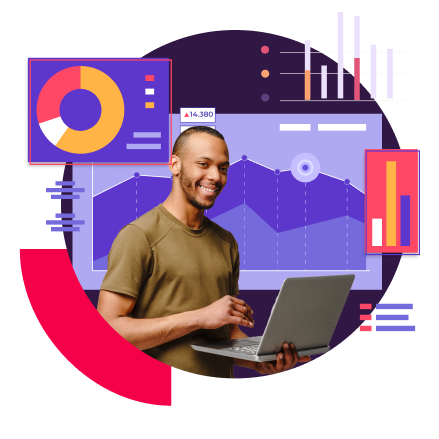
Adoption of analytics modeling and forecasting continues to emerge as a crucial strategy for DTC and B2B clients.
Companies that successfully navigate and actively shape the future of their marketplaces do so through a profound understanding of their data. At Common we help our clients leveraging the data already in their businesses to anticipate customer needs, optimize operational efficiency, and foster innovation.
At Common we support our clients in converting vast amounts of data into analytic models that inform every decision. These companies are not reactive but instead proactive and steps ahead of their competitors in their planning and execution for the future.
And, as analytics technology advances, Common is embracing those advances essential for sustained growth and competitiveness. The journey forward is clear: harnessing analytics models is no longer optional but a necessity for those aspiring to lead in their respective sectors.
Developing a Strong Planning Process
Common helps client’s use analytics modeling and revenue forecasting form the backbone of a rigorous growth planning and management. Common helps leadership teams develop repeated forward-looking decision-making by defining and predicting key business drivers, leading to a confident business plan, and quickly and regularly reviewing business trends to decisively pivot business plans over time.
Understanding Consumer Demand Data
In the DTC and B2B arenas, analytical modeling helps decipher the vast pools of consumer data that businesses accumulate. Blending statistical and mathematical methodologies these models help companies understand consumer behaviors, preferences, and trends.
This deep dive into consumer data enables businesses to understand the customer attributes and behaviors that drive desired business outcomes. At Common we use our clients’ data to support them in uncovering some of the following KPIs (this is just a small sample):
LTR, LTV, and repurchase rates by cohort and customer type
Churn/retention rates by product, customer type
Most profitable customer purchase paths
RFM (Recency/ Frequency/ Monetary) scoring
Subscription program health metrics
The ability to sift through and make sense of large datasets, helps to identify meaningful patterns and analytics models. They all serve as the backbone for crafting strategies that resonate well with the target audience. These models enable B2C and D2C companies to not just respond to market demands, but to anticipate them setting the stage for sustained success in a competitive landscape.
By effectively using the data analysis above, we help our clients to predict future buying behaviors. Common’s clients that embrace analytics modeling effectively adjust their strategies and business operations proactively, rather than reactively. This not only elevates the consumer experience by providing more personalized products and services but also streamlines operational processes, leading to enhanced efficiency and profitability.
Revenue Forecasting
Creating analytics models that support customer revenue forecasting is key in optimizing business operations and enhancing customer satisfaction. By leveraging data-driven insights, businesses improve overall operations including, inventory management, production schedules, hiring and staffing plans, and marketing efforts.
Inventory
One of the primary benefits of accurate revenue forecasting is the ability to optimize inventory levels. By predicting future demand, businesses ensure they have the right amount of the right product at the right time to meet customer needs without under- or over- stocking, tying up capital or mismanaging warehouse space.
Production Schedules
Common helps our clients to better manage their production schedules through revenue forecasting built on their data and analytics. By aligning manufacturing output with anticipated demand, companies minimize idle time and production bottlenecks while maximizing operational efficiency. The work that goes into creating accurate revenue forecasting, pays out in dividends by reducing costs while enhancing customer satisfaction through the timely delivery of products.
Hiring and Staffing Plans
Aligning team resources with expected demand is a challenge with any high-growth business. Accurate revenue forecasting enables additional analytics models to be built around what level of resourcing is needed from sales, support, or operational teams and to manage hiring plans as the business grows.
Marketing
Tailoring marketing efforts more precisely is another benefit of analytics models. By understanding when and where demand is likely to peak, Common clients allocate marketing resources to the right opportunities that drive sales. In the never ending quest to improve marketing campaigns to drive profitability, revenue forecasting is key.
Quickly Modify Forecasts by Incorporating New Data
All organizations need to be able to access the data rapidly to keep up with the pace of changing consumer behavior and fast-paced business decisions . Good analytical modeling and revenue forecasting directly tackle these challenges by equipping decision-makers with the insights needed for quick, informed choices.
Our clients often need to quickly substantiate their perspectives and recommendations with empirical evidence. By harnessing the easy access to clear and precise data through analytics models our c-suite clients make decisions rooted in a deep understanding of market dynamics and consumer behavior. Further, these leaders are able to align decisions closely with the ultimate goal of achieving sustained business growth and success. Some examples of how analytics models can drive forecasting success include:
Personal Viewing Recommendations
A streaming service might utilize analytics models to curate personalized viewing recommendations. These recommendations may subsequently increase subscription retention rates and enhance viewer engagement with the overall result of maximizing user satisfaction, customer loyalty and growth.
Supply Chain and Delivery Routes Optimization
Through revenue forecasting, a grocery store delivery service may increase the likelihood of accurately predicting patterns and adjusting inventory levels. These efforts would help reduce waste and drive improvements in delivery efficiency; ultimately resulting in higher customer satisfaction and operational savings.
Emerging Market Trends and Consumer Preferences
A health and wellness brand that implements analytics modeling can monitor shifting buying patterns and innovate product lines ahead of competitors, capturing increased market share and establishing a strong brand reputation for being at the forefront of consumer needs.
Explore our case studies.
We take a client-centric approach, prioritizing your goals and objectives throughout the engagement. Our commitment to open communication and collaboration ensures that we build lasting partnerships with our clients. Our track record speaks for itself having successfully helped numerous organizations transform their data into actionable insights, driving business growth and enhancing operational efficiency.
Scaling Reporting for Global Fitness Company
How Common Insights partnered with a popular personal fitness brand to scale the scope and…
BI Capabilities For A High-Growth D2C brand
How Common Insights guided a DTC beauty product disruptor into a new era of business intelligence…
Building BI Capabilities for a high-growth CPG Brand
How Common Insights built and developed business intelligence capabilities for a high-growth CPG…
Let's get started
Get in touch to organize a discovery call and let's find out how we can help your organization.



